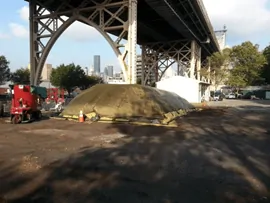


Engineering Design and CQA for an Aerated Static Pile – Composting Facility under the Queensboro Bridge, New York City, NY

Leah Retherford, Project Manager, Big Reuse, Inc.
The NYC Compost Project Hosted by Big Reuse is a program funded by the New York City Department of Sanitation (DSNY), which features a community composting facility, located under the Queensboro Bridge in Long Island City, New York. This program has worked to rebuild New York City’s soils by managing and operating food scrap drop-off sites, processing collected material, and distributing finished compost through stewardship events and to neighborhood partners. Outreach and education play a primary role in all program areas, which fulfills the mission to provide New Yorkers with the knowledge, skills, and opportunities they need to produce and use compost locally. The program has grown to host 14 food scrap drop-off sites, accept organic material from local partners (who manage food scrap drop-off sites) and from NYC Parks, and increase processing capacity.
Challenges
The compost site is on NYC Parks Department land. The NYC Compost Project Hosted by Big Reuse originally had informal permission to use an underutilized section of the NYC Parks compound in 2012, but had to vacate this parcel. NYC Parks approved use and development of another section of the NYC Parks compound in 2016.
The NYC Compost Project Hosted by Big Reuse retained SCS to provide design, construction oversight, and permitting support services in order to relocate the composting facility to the new location. The compost site uses the SG Mini™ System with GORE® Covers, which was developed by Sustainable Generation, and consists of a GORE® Cover placed over an aerated static pile.
The primary constraint of the composting site is proximity to neighbors. The site technology, infrastructure, and systems had to be designed to address common issues associated with compost processing sites. The proximity to a dense residential neighborhood allowed little tolerance for these issues and the site must be maintained as a clean, attractive, odor and pest-free site to avoid perceived or real nuisances to neighbors.
Outcomes and Benefits
The new composting facility layout doubled the processing capacity to 1000 tons of food scraps annually. Vector nuisances and odor generation are minimized through the use of the cover system, and contact water is collected and recycled back into the process.
The NYC Compost Project Hosted by Big Reuse is part of a decentralized, urban composting system that is sustainable and viable for urban settings and helps to advance the technology and equipment needed for sites of this scale. Similar processing sites could be sited and operated across New York City. Decentralized community compost sites can exist in dense urban settings and become neighborhood assets, as education centers, green spaces, and compost sources for community greening projects. With well-designed systems and appropriately-scaled equipment, they can be managed so that no odor or pest issues are created. These sites reduce carting distances and serve as an impetus for changing local land management practices by making high-quality compost abundantly available.
The project was completed on schedule and within budget.
The finished compost is used in community gardens, on street trees, and in public beautification projects.
Technical Design Details
The facility layout occupies a ½-acre parcel and includes the following: